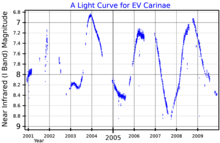용골자리 EV
| 관측 정보 역기점 J2000.0 분점 J2000.0 | |
|---|---|
| 별자리 | 용골자리 |
| 적경 | 10h 20m 21.608s[1] |
| 적위 | -60° 27′ 15.55″[1] |
| 겉보기등급 (V) | 7.4 - 9.0[2] |
| 특성 | |
| 진화 단계 | 적색초거성 |
| 스펙트럼 종류 | M4.5Ia[3][4] |
| U−B 색지수 | +2.34[5] |
| B−V 색지수 | +2.20[5] |
| 변광 종류 | SRc[6][2][7] |
| 위치천문학 | |
| 시선속도 (Rv) | 2.0[8] km/s |
| 고유운동 (μ) | RA: −6.1[9] mas/yr Dec.: 2.4[9] mas/yr |
| 연주 시차 (π) | 0.7759 ± 0.1098 mas[10] |
| 거리 | 2,960+220 −200[11] pc |
| 절대등급 (MV) | −5.24[5] |
| 상세 | |
| 질량 | 5.36[12] M☉ |
| 반지름 | 1,168[13] R☉ |
| 복사 광도 | 288,000+75,000 −79,000[11] L☉ |
| 유효온도 | 3,535±170[14] K |
| 금속함량 [Fe/H] | +0.25[12] dex |
| 천체 명칭 | |
| 데이터베이스 자료 | |
| SIMBAD | 데이터 |
용골자리 EV는 용골자리에 존재하는 분광형 M4Ia의 적색초거성 맥동변광성이다. 이 별은 겉보기등급이 가시광선 대역에서 7.4~9.0 사이로 변하는 준규칙 변광성으로, 쌍안경이나 망원경으로만 볼 수 있다. 다양한 주기가 확인되었지만 주요 주기는 약 347일이다.[6] M4.5Ia형의 MK 분광형 표준별이다.[4]

용골자리 EV는 그 특성이 거리에 따라 다르지만 알려진 가장 반지름이 큰 별 중 하나다. 20세기 후반, 추정 거리 4.2kpc를 기준으로 용골자리 EV는 태양(L☉)의 550,000~675,000배에 달하는 드문 광도를 지닌 매우 밝고 큰 초거성인 것으로 밝혀졌었다. 이는 2,930 K의 온도에서 반경이 태양 반경(R☉)의 2,880~3,190배에 달해 토성의 궤도보다 크다는 것을 의미한다.[16]
최근에는 거리에 대한 새로운 계산을 통해 3kpc 미만의 더 가까운 거리가 도출되었으며 이는 용골자리 OB2 성협의 용골자리 EV 부분을 용골자리 성운을 따라 위치하게 하고 별의 광도가 300,000 L☉ 미만으로 낮아지고 온도가 높아져 이에 따라 반경 값이 낮아지게 된다.[13][5][11] 0.7759±0.1098 mas의 Gaia Data Release 2 시차를 기반으로 한 복사광도 계산은 반경 574 R☉에 50,000 L☉ 미만의 광도를 제공하지만 해당 값은 매우 높은 수준의 천문 소음으로 인해 신뢰할 수 없는 것으로 간주된다.[14]
각주[편집]
- ↑ 가 나 Cutri, Roc M.; Skrutskie, Michael F.; Van Dyk, Schuyler D.; Beichman, Charles A.; Carpenter, John M.; Chester, Thomas; Cambresy, Laurent; Evans, Tracey E.; Fowler, John W.; Gizis, John E.; Howard, Elizabeth V.; Huchra, John P.; Jarrett, Thomas H.; Kopan, Eugene L.; Kirkpatrick, J. Davy; Light, Robert M.; Marsh, Kenneth A.; McCallon, Howard L.; Schneider, Stephen E.; Stiening, Rae; Sykes, Matthew J.; Weinberg, Martin D.; Wheaton, William A.; Wheelock, Sherry L.; Zacarias, N. (2003). “VizieR Online Data Catalog: 2MASS All-Sky Catalog of Point Sources (Cutri+ 2003)”. 《CDS/ADC Collection of Electronic Catalogues》 2246: II/246. Bibcode:2003yCat.2246....0C.
- ↑ 가 나 Kiss, L. L.; Szabó, Gy. M.; Bedding, T. R. (2006). “Variability in red supergiant stars: Pulsations, long secondary periods and convection noise”. 《Monthly Notices of the Royal Astronomical Society》 372 (4): 1721–1734. arXiv:astro-ph/0608438. Bibcode:2006MNRAS.372.1721K. doi:10.1111/j.1365-2966.2006.10973.x. S2CID 5203133.
- ↑ “GCVS Query=EV Car”. 《Sternberg Astronomical Institute》. General Catalogue of Variable Stars @ Sternberg Astronomical Institute, Moscow, Russia. 2020년 8월 11일에 확인함.
- ↑ 가 나 Keenan, Philip C.; McNeil, Raymond C. (1989). “The Perkins catalog of revised MK types for the cooler stars”. 《Astrophysical Journal Supplement Series》 71: 245. Bibcode:1989ApJS...71..245K. doi:10.1086/191373. S2CID 123149047.
- ↑ 가 나 다 라 Mauron, N.; Josselin, E. (2011). “The mass-loss rates of red supergiants and the de Jager prescription”. 《Astronomy and Astrophysics》 526: A156. arXiv:1010.5369. Bibcode:2011A&A...526A.156M. doi:10.1051/0004-6361/201013993. S2CID 119276502.
- ↑ 가 나 Samus, N. N.; Durlevich, O. V.; 외. (2009). “VizieR Online Data Catalog: General Catalogue of Variable Stars (Samus+ 2007-2013)”. 《VizieR On-line Data Catalog: B/GCVS. Originally Published in: 2009yCat....102025S》 1. Bibcode:2009yCat....102025S.
- ↑ Percy, John R.; Sato, Hiromitsu (2009). “Long Secondary Periods in Pulsating Red Supergiant Stars”. 《Journal of the Royal Astronomical Society of Canada》 103 (1): 11. Bibcode:2009JRASC.103...11P.
- ↑ Feast, M. W.; Woolley, R.; Yilmaz, N. (1972). “The kinematics of semi-regular red variables in the solar neighbourhood”. 《Monthly Notices of the Royal Astronomical Society》 158: 23–46. Bibcode:1972MNRAS.158...23F. doi:10.1093/mnras/158.1.23.
- ↑ 가 나 Høg, E.; Fabricius, C.; Makarov, V. V.; Urban, S.; Corbin, T.; Wycoff, G.; Bastian, U.; Schwekendiek, P.; Wicenec, A. (2000). “The Tycho-2 catalogue of the 2.5 million brightest stars”. 《Astronomy and Astrophysics》 355: L27. Bibcode:2000A&A...355L..27H. doi:10.1888/0333750888/2862.
- ↑ Brown, A. G. A.; 외. (Gaia collaboration) (August 2018). “Gaia Data Release 2: Summary of the contents and survey properties”. 《Astronomy & Astrophysics》 616. A1. arXiv:1804.09365. Bibcode:2018A&A...616A...1G. doi:10.1051/0004-6361/201833051. 이 출처의 Gaia DR2 기록 - VizieR.
- ↑ 가 나 다 Davies, Ben; Beasor, Emma R. (March 2020). “The 'red supergiant problem': the upper luminosity boundary of Type II supernova progenitors”. 《MNRAS》 (영어) 493 (1): 468–476. arXiv:2001.06020. Bibcode:2020MNRAS.493..468D. doi:10.1093/mnras/staa174. S2CID 210714093.
- ↑ 가 나 Anders, F.; Khalatyan, A.; Chiappini, C.; Queiroz, A. B.; Santiago, B. X.; Jordi, C.; Girardi, L.; Brown, A. G. A.; Matijevič, G.; Monari, G.; Cantat-Gaudin, T.; Weiler, M.; Khan, S.; Miglio, A.; Carrillo, I.; Romero-Gómez, M.; Minchev, I.; De Jong, R. S.; Antoja, T.; Ramos, P.; Steinmetz, M.; Enke, H. (2019). “Photo-astrometric distances, extinctions, and astrophysical parameters for Gaia DR2 stars brighter than G = 18”. 《Astronomy and Astrophysics》 628: A94. arXiv:1904.11302. Bibcode:2019A&A...628A..94A. doi:10.1051/0004-6361/201935765. S2CID 131780028.
- ↑ 가 나 Van Loon, J. Th.; Cioni, M.-R. L.; Zijlstra, A. A.; Loup, C. (2005). “An empirical formula for the mass-loss rates of dust-enshrouded red supergiants and oxygen-rich Asymptotic Giant Branch stars”. 《Astronomy and Astrophysics》 438 (1): 273–289. arXiv:astro-ph/0504379. Bibcode:2005A&A...438..273V. doi:10.1051/0004-6361:20042555. S2CID 16724272.
- ↑ 가 나 Messineo, M.; Brown, A. G. A. (2019). “A Catalog of Known Galactic K-M Stars of Class I Candidate Red Supergiants in Gaia DR2”. 《The Astronomical Journal》 158 (1): 20. arXiv:1905.03744. Bibcode:2019AJ....158...20M. doi:10.3847/1538-3881/ab1cbd. S2CID 148571616.
- ↑ “ASAS All Star Catalogue”. The All Sky Automated Survey. 2021년 12월 8일에 확인함.
- ↑ de Jager, C.; Nieuwenhuijzen, H.; van der Hucht, K. A. (1988). “Mass loss rates in the Hertzsprung-Russell diagram”. 《Astronomy and Astrophysics Supplement Series》 72 (2): 259–289. Bibcode:1988A&AS...72..259D.

